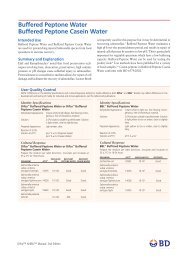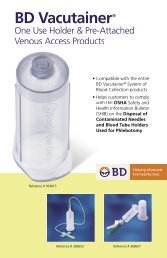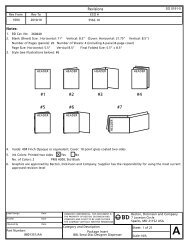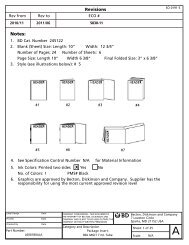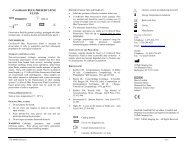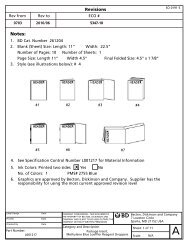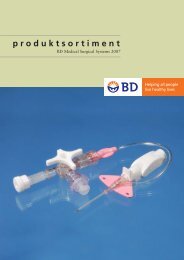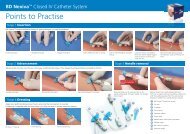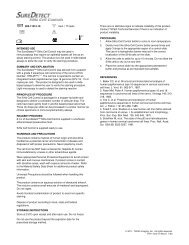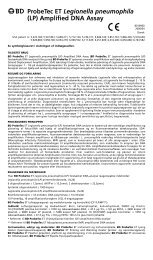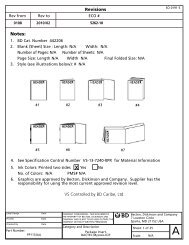Calcofluor White Reagent Droppers - BD
Calcofluor White Reagent Droppers - BD
Calcofluor White Reagent Droppers - BD
Create successful ePaper yourself
Turn your PDF publications into a flip-book with our unique Google optimized e-Paper software.
3. Mark off a well-defined square on the slide with a wax marking pencil.<br />
4. Apply the specimen to the area within the wax square on the slide; allow to air dry.<br />
5. Cover the area within the square with 100% methanol; allow to air dry.<br />
6. Add sufficient 10% potassium hydroxide solution to just cover the specimen. Do not<br />
saturate. Wait for 5 s.<br />
7. Hold <strong>Calcofluor</strong> <strong>White</strong> <strong>Reagent</strong> dropper upright and POINT TIP AWAY FROM YOURSELF.<br />
Grasp the middle with thumb and forefinger and squeeze gently to break ampule inside<br />
the dropper. Caution: Break ampule close to its center one time only. Do not manipulate<br />
the dropper any further as the plastic may puncture and injury may occur. Tap the bottom<br />
of the dropper on the tabletop a few times. Invert for convenient drop-by-drop dispensing<br />
of the reagent.<br />
8. Add 1 to 2 drops of <strong>Calcofluor</strong> <strong>White</strong> <strong>Reagent</strong> to the area within the square. Wait for 2 min.<br />
9. Drain excess <strong>Calcofluor</strong> <strong>White</strong> <strong>Reagent</strong> from the slide.<br />
10. Using a fluorescent microscope view the specimen:<br />
a. To view as a wet mount slide, add <strong>Calcofluor</strong> <strong>White</strong> <strong>Reagent</strong>, as needed, a cover slip and<br />
view with appropriate objective.<br />
- or -<br />
b. To view under oil immersion, after air-drying, view directly.<br />
User Quality Control:<br />
1. Examine the staining solution for signs of deterioration (see “Product Deterioration”).<br />
2. Check the performance of the stain with fresh cultures of Candida albicans ATCC 10231<br />
(positive) and Escherichia coli ATCC 25922 (negative).<br />
Quality control requirements must be performed in accordance with applicable local, state<br />
and/or federal regulations or accreditation requirements and your laboratory’s standard<br />
Quality Control procedures. It is recommended that the user refer to pertinent NCCLS guidance<br />
and CLIA regulations for appropriate Quality Control practices.<br />
RESULTS<br />
When exposed to light of the suggested wavelength (300 – 412 nm), fungi will fluoresce a<br />
bright apple green or blue white color. Bacteria will fluoresce weakly or not at all.<br />
LIMITATIONS OF THE PROCEDURE<br />
Many clinical laboratories now use fluorescence microscopy for the examination of other<br />
stains. For best results with <strong>Calcofluor</strong> <strong>White</strong> <strong>Reagent</strong>, a mercury vapor rather than a quartz<br />
halogen lamp, and UV/BV excitation are recommended. 1 Microscopes fitted with selective<br />
filters for the excitation of fluorescein (KP490 interference filter) are not recommended since<br />
these filters prevent the proper wave length from striking the specimen. 1<br />
Certain debris may fluoresce and should be distinguished from fungal elements on the basis<br />
of morphology.<br />
<strong>Calcofluor</strong> <strong>White</strong> <strong>Reagent</strong> <strong>Droppers</strong> are used for the presumptive identification of fungi. All<br />
positive smears should be confirmed by culture.<br />
Although the cells themselves of Cryptococcus will stain with calcofluor white, it has been<br />
reported that the capsule will not; further testing for confirmation is recommended.<br />
Bacteria may fluoresce, although to a lesser degree than fungi and may be confused with<br />
calcofluor white-stained artifacts. The presence of fungi should be determined on the basis<br />
of morphology.<br />
Fluorescent staining intensity may vary depending on the organism being stained.<br />
PERFORMANCE CHARACTERISTICS<br />
<strong>BD</strong> conducted a study of the <strong>BD</strong> <strong>Calcofluor</strong> <strong>White</strong> <strong>Reagent</strong> using the following organisms:<br />
Aspergillus sp. (ATCC 36607) Candida albicans (ATCC 10231)<br />
Candida guilliermondii (ATCC 14242) Cladosporium sp. (ATCC 13026)<br />
Microsporum canis (ATCC 10214) Penicillium roquefortii (ATCC 9295)<br />
Candida glabrata (ATCC 2001)<br />
All slides were prepared in triplicate with the wet mount method as described in the "GENERAL<br />
SPECIMENS" section of the Test Procedure (including the use of 10% potassium hydroxide<br />
reagent). There was one high positive control slide (cellulose via cotton fibers) and two negative<br />
control slides (Escherichia coli ATCC 25922 and an uninoculated slide).<br />
Slides were examined with a fluorescence microscope (Olympus, BH-2) equipped with a 100w<br />
mercury lamp, exciter filter (490 nm) and barrier filter (545 nm).<br />
The organisms evaluated in this study exhibited appropriate fluorescent staining characteristics.<br />
AVAILABILITY<br />
Cat. No. Description<br />
261195 <strong>BD</strong> <strong>Calcofluor</strong> <strong>White</strong> <strong>Reagent</strong> <strong>Droppers</strong>, packaged 50 droppers/carton.<br />
261191 <strong>BD</strong> 10% Potassium Hydroxide <strong>Reagent</strong> <strong>Droppers</strong> packaged 50 droppers/carton.<br />
REFERENCES<br />
1. Harrington, B.J., and G.J. Hageage, Jr. 1991. <strong>Calcofluor</strong> white: tips for improving its use.<br />
Clin. Microbiol. Newsl. 13:3-5.<br />
2. Monheit, J.E., D.F. Cowan, and D.G. Moore. 1984. Rapid detection of fungi in tissues using<br />
calcofluor white and fluorescence microscopy. Arch. Pathol. Lab. Med. 108:616-618.<br />
3. Stringer, J.R., C.B. Beard, R.F. Miller, and A.E. Wakefield. 2002. A new name (Pneumocystis<br />
jiroveci) for Pneumocystis from humans. Emerg. Infect. Dis. 8(9):891-6.<br />
4. Baselski, V.S., M.K. Robinson, L.W. Pifer, and D.R. Woods. 1990. Rapid detection of<br />
Pneumocystis carinii in bronchoalveolar lavage samples by using Cellufluor staining. J. Clin.<br />
Microbiol. 28:393-394.<br />
5. Kim, Y.K., S. Parulekar, P.K.W. Yu, R.J. Pisani, T.F. Smith, and J.P. Anhalt. 1990. Evaluation of<br />
calcofluor white stain for detection of Pneumocystis carinii. Diagn. Microbiol. Infect. Dis.<br />
13:307-310.<br />
6. Hageage, G.J., and B.J. Harrington. 1984. Use of calcofluor white in clinical mycology. Lab.<br />
Med. 15:109-112.<br />
7. National Committee for Clinical Laboratory Standards. 2001. Approved Guideline M29-A2.<br />
Protection of laboratory workers from occupationally acquired infections, 2nd ed. NCCLS,<br />
Wayne, Pa.<br />
8. Garner, J.S. 1996. Hospital Infection Control Practices Advisory Committee, U.S. Department<br />
of Health and Human Services, Centers for Disease Control and Prevention. Guideline for<br />
isolation precautions in hospitals. Infect. Control Hospital Epidemiol. 17:53-80.<br />
2




